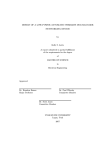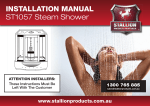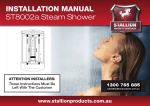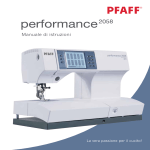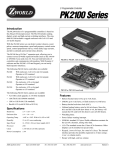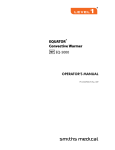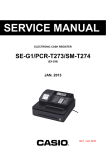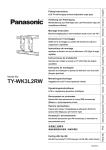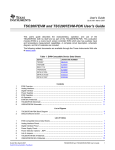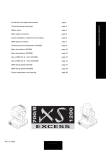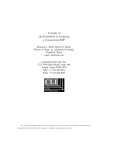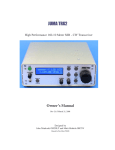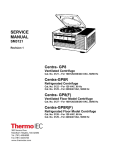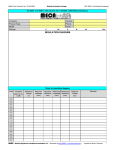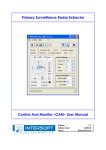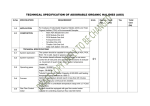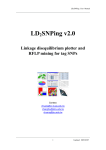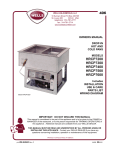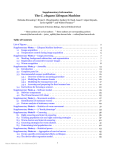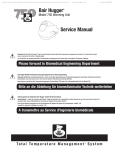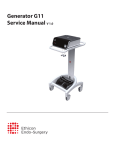Download Service Manual
Transcript
EQ-5000 ® EQUATOR Convective Warmer REF EQ-5000 100V REF EQ-5000 115V REF EQ-5000 230V Service Manual P/N 4533902-GB Rev A Copyright EQUATOR ® Convective Warmer Part Number: 4533902-GB Rev. A (2005-01) This revision supercedes all previous revisions. Under copyright laws, this manual may not be reproduced in any form, in whole, or in part, without prior written permission of Smiths Medical ASD, Inc. (Smiths Medical ASD). Level 1 and EQUATOR are trademarks of the Smiths Medical family of companies. The symbol ® indicates the trademark is registered in the U. S. Patent and Trademark office and certain other countries. Every effort has been made to ensure that the information in this manual is accurate and details provided are correct at the time of printing. The company, however, reserves the right to improve the equipment shown. Other company and product names mentioned herein are trademarks of their respective companies. Mention of third-party products is for informational purposes only and constitutes neither an endorsement nor a recommendation. Smiths Medical ASD assumes no responsibility with regard to the performance or use of these products. For further information, please call the local Smiths Medical ASD representative or Smiths Medical ASD direct at 1-800-258-5361 or +1-781-878-8011. ©2005 Smiths Medical family of companies. All rights reserved. The products described are covered by one or more of the following U.S. Patent Nos. 5,785,723; 6,143,020; 6,277,144; 6,440,157; other patent(s) pending; foreign patent(s) pending. Manufactured in the U.S.A. Contents Contents v vi vi vi vii ix ix ix x x xi 1 1 1 2 3 3 3 4 7 7 9 10 12 12 13 14 16 17 18 18 19 19 20 21 22 22 22 23 25 26 28 30 32 32 34 34 35 36 38 Introduction Abbreviations Used in the Manual Appropriate Use and Service Indications for Use Symbols Service Information Warranty Service Non-Warranty Service Returning the Device for Service Service Contacts Important Safety Information 1 Description EQUATOR ® Convective Warmer Convective Warming Blankets Control Panel 2 Preventive Maintenance Recommended Schedule Cleaning the Hose and Enclosure Replace the Air Filter 3 Functional Test and Calibration Procedure Functional Test and Calibration Procedure Checklist Instrument Test Setup Preliminary Voltage Checks and Adjustments Functional Tests Test 1: Self-Test Sequence Test 2: Disconnect Indicator Test Test 3: HI Temperature Test Test 4: MED Temperature Test Test 5: LO Temperature Test Test 6: LO OverTemp and UnderTemp Test Test 7: MED OverTemp and UnderTemp Test Test 8: HI OverTemp and UnderTemp Test Test 9: Ambient OverTemp Test Test 10: OverTemp and UnderTemp Readjustment Test 11: Temperature DownStep Alarm Delay Check Test 12: Fire Safety Thermostat Function Test Test Completion Shut Down the Instrument Determine Instrument Disposition 4 Component Removal and Replacement Open the Enclosure Replace the Motor Driver Electronic Assembly Replace the Motor Replace the Impeller Replace the Heater Replace the Hose Microswitch Assembly Replace the Air Outlet Replace the Pole Clamp Replace the Control Panel Replace the Power Supply Assembly EQUATOR ® Convective Warmer Service Manual iii Contents A Reference Diagrams B Troubleshooting General Failures Airflow Failures Heat Related Failures Self-Test Does Not Complete Self-Test Completes Thermal Runaway – Device Causes T-Stat to Open Safety Leakage Test C Specifications D Parts List E Schematic Drawings Maintenance Log iv EQUATOR ® Convective Warmer Service Manual 39 43 43 44 44 45 46 47 47 49 51 55 61 Introduction Introduction This manual provides qualified hospital facility biomedical technicians and other qualified service facility personnel with procedures to service and make repairs to the EQUATOR ® Convective Warmer – 100V/115V/230V. Only trained, qualified personnel knowledgeable of the good practices for servicing and repairing medical devices should service the device. Perform service and repairs according to the procedures described in this manual. ________________________________________________________________ • WARNING! Electrocution Hazard. There are no user-serviceable parts inside the enclosure. Only competent personnel knowledgeable in the safety procedures required for servicing live Mains parts shall be allowed to open the enclosure. ________________________________________________________________ Note: Any EQUATOR ® Convective Warmer circuit modifications or electronic assembly component replacements by persons other than those authorized by Smiths Medical ASD are strictly forbidden. Any adjustment or repair of the EQUATOR ® Convective Warmer must be performed at a properly grounded ESD workstation using the procedures presented in this manual. Read and follow instructions and all accompanying documents. Failure to follow instructions could lead to misuse of the device or device malfunction. The manual is divided into the following sections: Section Contains Chapter 1 Describes general information about the device Chapter 2 Procedures to perform scheduled maintenance Chapter 3 Functional tests used to check the safety functions of the device Chapter 4 Procedures to replace components of the device Appendix A Diagrams for the Mains and Control Electronic Assembly Appendix B Causes and solutions for troubleshooting device issues Appendix C System specifications Appendix D List of parts available to order Appendix E Circuit drawings Maintenance Log Form to record maintenance tasks EQUATOR ® Convective Warmer Service Manual v Introduction Abbreviations Used in the Manual Abbreviation DVM TA TP LED AMB LO MED HI OT UT Definition Digital Volt Meter Thermo-Anemometer Test Points Light Emitting Diode Ambient – Room Temperature Low Temperature – 36°C Medium Temperature – 40°C High Temperature – 44°C Over Temperature Under Temperature Appropriate Use and Service Smiths Medical ASD cannot assume responsibility for performance, safety, and reliability of the device when any of the following situations occur: • Any adjustments and repairs are performed by unauthorized personnel. • The device is not used according to the manufacturer’s recommendations. • The procedures described in the EQUATOR ® Convective Warmer Operator’s Manual and in this service manual are not followed. • Environmental operating conditions and location recommendations are not followed. Indications for Use The EQUATOR ® Convective Warmer is intended for thermal regulating of a patient’s temperature by a warm-air-heated blanket system. It is designed to prevent hypothermia and/or reduce cold discomfort before, during, and after surgical procedures. It is intended for use by appropriately trained healthcare professionals in clinical environments. vi EQUATOR ® Convective Warmer Service Manual Introduction Symbols The following symbols are used in the manual, and on the device and disposables. Symbol Definition Power ON Button Power OFF Button Ambient Temperature Setting Button (Start up setting) 36°C Temperature Setting Button 40°C Temperature Setting Button 44°C Temperature Setting Button Over Temperature Alarm Indicator Under Temperature Indicator Disconnect LED Elapsed Time Display (h=hour) Hose End Temperature Type BF Equipment Protected Against Dripping Water EQUATOR ® Convective Warmer Service Manual vii Introduction Symbol Definition Catalog Number Serial Number Part Number Batch Code Authorized Representative in the European Community Manufacturer Date of Manufacture Quantity Protective Earth [Ground] Alternating Current Do Not Reuse Attention, see instructions for use Electrical Shock Hazard Latex Free Caution: Federal law (U.S.A.) restricts this device to sale by or on the order of a physician. Protective earth terminal Temperature limitation Use by viii EQUATOR ® Convective Warmer Service Manual Introduction Symbol Definition Recyclable Product Device has been tested by National Technical Systems, a nationally recognized technical lab, to meet U.S. requirements for safety. CE Mark and Notified Body number (0473 indicates AMTAC) Humidity limitation Sterilized using ethylene oxide Non-sterile CONTRAINDICATION CAUTION! WARNING! A Contraindication statement alerts the user to conditions when the device should not be used. A Caution statement alerts the user to conditions that may cause damage to the device. A Warning statement alerts the user to conditions that may cause personal injury to the user or patient. Service Information All service must be performed by Smiths Medical ASD or a Smiths Medical ASD authorized representative. Service by any other person or organization voids the warranty and transfers liability for malfunctions of the device to the servicing organization. Warranty Service Devices received for repair that have not been obviously abused or impactdamaged and are still under warranty will be promptly repaired and returned at no charge. A no-charge purchase order is requested for tracking. Refer to the EQUATOR ® Convective Warmer Operator’s Manual for the complete text of the limited warranty. Non-Warranty Service Devices received that have suffered obvious abuse or impact damage and devices no longer under warranty will be promptly inspected and a verbal EQUATOR ® Convective Warmer Service Manual ix Introduction estimate of repair cost will be given to you. A purchase order will be required from the hospital consistent with the verbal estimate. A written estimate will be provided upon request. Returning the Device for Service Before returning the EQUATOR ® Convective Warmer for service, contact Smiths Medical ASD for Returned Goods Authorization. Note: The EQUATOR ® Convective Warmer must be cleaned and disinfected for repair shipment or it will be immediately returned as received. Service Contacts Contact Smiths Medical ASD Technical Service Department or Smiths Medical ASD distributor at: USA/Canada Smiths Medical ASD, Inc. Anesthesia and Safety Devices Division 160 Weymouth Street Rockland, MA 02370 USA USA/Canada 1-800-258-5361 International 1-781-878-8011 European Representative Smiths Medical International Ltd Watford, Herts, WD24 4LG, UK Tel +44 (0) 1923 246434 Fax +44 (0) 1923 240273 Australian Representative Smiths Medical Australasia Pty. Ltd. 61 Brandl Street, Brisbane Technology Park Eight Mile Plains, QLD 4113, Australia Tel +61 (0) 7 3340 1300 Fax +61 (0) 7 3340 1399 x EQUATOR ® Convective Warmer Service Manual Introduction Important Safety Information • • CONTRAINDICATIONS Thermal injury may occur if convective warming therapy is applied to lower extremities during aortic cross-clamping procedures. Thermal injury may occur if convective warming therapy is applied to ischemic limbs. WARNING! Death or serious injury may occur if these warnings are not followed: • Read and follow all instructions and accompanying documents. Failure to follow instructions could lead to misuse of the device or device malfunction. • Electrocution Hazard. There are no user-serviceable parts inside the enclosure. Only competent personnel knowledgeable in the safety procedures required for servicing live Mains parts shall be allowed to open the enclosure. • Blankets are for single use only. To reduce the risk of cross contamination, do not reuse blankets. • Cover all open wounds under the warming blanket to prevent airborne contamination. • Grounding reliability can only be achieved when the Mains power cord is connected to a properly grounded receptacle. Risk of electrical shock exists if the equipment is not connected to a properly grounded receptacle resulting in death or serious injury to the patient or user. • Exposed conductors on the Mains power cord can cause an electrocution hazard. Remove the device from service if the Mains power cord has exposed wires. • The EQUATOR ® Convective Warmer must be calibrated by Smiths Medical ASD or Smiths Medical ASD authorized personnel. • Do not use the EQUATOR ® Convective Warmer in high-energy fields such as: Cauterizers, MRI, X-RAY, portable and mobile RF communications equipment, and other such devices. The EQUATOR ® Convective Warmer may act as a projectile in a strong magnetic field, cause image artifacts, or not function as intended. • Do not use the EQUATOR ® Convective Warmer in the presence of a flammable anesthetic mixture with air, oxygen, or nitrous oxide. The risk EQUATOR ® Convective Warmer Service Manual xi Introduction of explosion exists if the device is operated in a potentially explosive environment. • To prevent fire hazard and possible damage to the EQUATOR ® Convective Warmer, use only fuses specified. Only competent personnel knowledgeable in the safety procedures required for servicing live Mains parts shall be allowed to open the enclosure. CAUTION! Thermal injury may occur if these cautions are not followed: • If Over Temperature audible alarm sounds and/or red Over Temperature alarm indicator illuminates, discontinue use of the convective warmer and remove from service. Contact Smiths Medical ASD or an authorized representative for service. • If the EQUATOR ® Convective Warmer does not perform its self-test properly, fails to operate, or stops while running, discontinue use of the convective warmer and remove it from service. Contact Smiths Medical ASD or an authorized representative for service. • Hose Nozzle MUST be connected to a compatible Forced Air Blanket. • Monitor the temperature of the patient at regular intervals. • Periodically observe cutaneous response under blanket. If erythema is evident, decrease the temperature setting or discontinue use of convective warming therapy. • Do not place objects onto the blanket that will obstruct airflow. • If equipment malfunction is evident, discontinue use of the EQUATOR ® Convective Warmer and remove it from service. Contact Smiths Medical ASD or an authorized representative for service. • Use only blankets manufactured and/or approved by Smiths Medical ASD. • Warming unit must be calibrated by competent personnel authorized by Smiths Medical ASD. • Federal law (USA) restricts this device to sale by or on the order of a physician. Physical injury to the user and/or patient may occur if these cautions are not followed: • xii Ensure that the EQUATOR ® Convective Warmer IV pole mounting clamp is properly tightened before each use. EQUATOR ® Convective Warmer Service Manual Introduction • Do not mount the EQUATOR ® Convective Warmer higher than 46” (1.17m) on the IV pole. For convenience, 46” (1.17m) is indicated by a black mark on the EQ-5000 power cord. Mounting the device above 46” (1.17m) may result in instability of the pole and tipping. • Do not change filter while unit is operating. EQUATOR ® Convective Warmer Service Manual xiii Introduction xiv EQUATOR ® Convective Warmer Service Manual Chapter 1 Description 1 Description EQUATOR ® Convective Warmer The EQUATOR ® Convective Warmer is used to reduce hypothermia and patient discomfort before, during and after surgical procedures. The system consists of a high-flow warming device with hose-end temperature control and a single-use blanket. The EQUATOR ® Convective Warmer draws ambient-temperature air through a particulate air filter. The filtered air is warmed to a selected temperature. The warmed air enters the blanket through the hose and is distributed through delivery channels to the patient. Perforations on the patient side of the air delivery channels in the blanket gently disperse warm air over the patient, thereby maintaining patient temperature. The warming device has three outlet temperature settings that provide flexibility in patient treatment: 36°C, 40°C, and 44°C. These three temperature settings are servo-controlled by thermistors placed at the hose end that connects to the blanket. A fourth temperature setting delivers ambient-temperature air. The temperature indicated on the display of the warming device is the temperature of the air being delivered to the blanket at the end of the hose. An over-temperature system monitors the air temperature at the end of the hose that connects to the blanket. A control thermistor adjusts the power applied to the heater in the warming device to maintain the selected temperature. This enables the system to maintain the selected temperature under variations in ambient temperature. A safety thermistor provides a signal to a separate high temperature comparison circuit. The safety thermistor activates and alarms if the temperature exceeds the set point. The safety circuit provides an independent means of shutoff, which discontinues power to the heater and blower. This prevents patient exposure to excessive temperatures in a single fault failure of the temperature controller. Convective Warming Blankets The blanket consists of two layers of non-woven polypropylene fabric coated with a layer of polyethylene. The layers are bonded together to form a distribution network of air delivery channels. The warm air is distributed around the blanket through the delivery channels and exits the blanket through a specially designed series of perforations in the patient side of the blanket. The distribution of air is designed to minimize temperature differences throughout the blanket. EQUATOR ® Convective Warmer Service Manual 1 Chapter 1 Description Control Panel Figure 1-1 identifies the controls and indicators seen on the control panel. Symbol Definition Power ON Button Power OFF Button Ambient Temperature Setting Button (Start up setting) 36°C Temperature Setting Button 40°C Temperature Setting Button 44°C Temperature Setting Button Over Temperature Alarm Indicator Under Temperature Indicator Disconnect LED Attention, consult accompanying documents Elapsed Time Display (h=hour) Hose End Temperature Figure 1-1 Controls and Indicators 2 EQUATOR ® Convective Warmer Service Manual Chapter 2 Preventive Maintenance 2 Preventive Maintenance The EQUATOR ® Convective Warmer (device) requires only minimal preventive maintenance to maintain its appearance and assure normal operation over the life of the instrument. Recommended Schedule • Enclosure cleaning: semi-annually, or as required to preserve the enclosure’s appearance. • Hose cleaning: as necessary. • Replacement of the air filter: annually, or as required to assure unrestricted airflow. Tools and Equipment The following tools, equipment, and cleaning agents are necessary to perform the maintenance procedures explained in this chapter: • For enclosure and hose cleaning: a mild, non-abrasive detergent diluted in warm water. • For air filter replacement: Phillips-head screwdriver. Cleaning the Hose and Enclosure 1. Disconnect the power cord from both the electrical outlet and from the rear of the device. 2. If a chassis-ground cable is connected to the grounding stud (located below the power cable connector) at the rear of the device, disconnect the cable. 3. Remove the hose from the device: a. Disconnect the hose thermistor cable from the rear of the device by turning the knurled knob on the thermistor receptacle counterclockwise, until the cable can be unplugged and removed from the device. b. Grasp the hose connector, twist, and pull it straight out from the air outlet at the rear panel. 4. Remove the device from the pole if pole mounted. EQUATOR ® Convective Warmer Service Manual 3 Chapter 2 Preventive Maintenance 5. Using a dampened cloth or sponge, wipe down the enclosure and hose as needed. Note: Do not use alcohol or other strong solvents to clean the hose or exterior surfaces of the device. These solutions may damage the label and other parts. Note: Do not use a soaking wet cloth to clean the hose or exterior surfaces of the device. Water may drip or seep into the electrical connectors and components at the rear of the device and into the air intake opening at the bottom of the enclosure. Electrical components and the air filter could be damaged if they become wet. 6. Wipe the entire enclosure and hose dry using a soft, dry cloth. 7. Record the task on the maintenance log. Replace the Air Filter ________________________________________________________________ • CAUTION! Do not change the air filter while the device is operating. ________________________________________________________________ 1. Disconnect the power cord from both the electrical outlet and from the rear of the device. 2. Remove the device from the pole if pole mounted. Lay device on its side. 3. Remove the four small Philips screws on bottom securing the filter in place. Refer to Figure 2-1. 4 EQUATOR ® Convective Warmer Service Manual Chapter 2 Preventive Maintenance Bottom of Device Filter Assembly Figure 2-1 Air Filter Replacement 4. Discard the old filter assembly. 5. Inspect the new filter gasket assembly to be sure it is clean and unmarked. 6. Install new filter assembly using the original screws. 7. Record the task on the maintenance log. EQUATOR ® Convective Warmer Service Manual 5 Chapter 2 Preventive Maintenance 6 EQUATOR ® Convective Warmer Service Manual Chapter 3 Functional Test and Calibration Procedure 3 Functional Test and Calibration Procedure The Functional Test and Calibration Procedure is a series of tests used to determine if the EQUATOR ® Convective Warmer (device) is operating within its design specifications and that all safety features are functional. The procedure also describes steps to perform minor adjustments that may be required. Some test procedures require service access to components that are internal to the device. For information describing how to access those internal components, refer to the Open the Enclosure procedure in Chapter 4. Tools and Equipment The following tools and equipment are needed to perform the Functional Test and Calibration Procedure: • 4½ digit Digital Volt Meter (DVM) • Stopwatch • Calibrated thermo-anemometer (TA) • Meter/Power supply cable Functional Test and Calibration Procedure Checklist The following table shows the Functional Test and Calibration Procedure Checklist required for the test procedures in this chapter. The Checklist provides a convenient tool for measuring/recording test results against appropriate default tolerance values specified for each procedure. Note: Copy the Checklist for use during the Functional Test and Calibration Procedure. EQUATOR ® Convective Warmer Service Manual 7 Chapter 3 Functional Test and Calibration Procedure Functional Test and Calibration Procedure Checklist Device Serial Number: Date of Test: Name of Technician: 8 Test Item Number Method Tolerance Test Result 1. Self-Test Sequence Verification Verify Pass/Fail 3 Pass Fail 2. Disconnect Indicator Test Verification Verify Pass/Fail 3 Pass Fail 3. Disconnect Safety Test Verification Verify Pass/Fail 3 Pass Fail 4. HI Temp Reading (TA) TA Read 43-45°C °C 5. HI Temp Reading (Control panel) Device Read 43–45°C °C 6. HI Temp Reading (DVM) DVM Read 0.435–0.455 Vdc Vdc 7. HI Temp Airflow (w/New filter) TA Read 1650–1850 ft/min ft/min 8. MED Temp Reading (TA) TA Read 39-41°C °C 9. MED Temp Reading (Control panel) Device Read 39–41°C °C 10. MED Temp Reading (DVM) DVM Read 11. LO Temp Reading (TA) 0.395–0.415 Vdc Vdc TA Read 35-37°C °C 12. LO Temp Reading (Control panel) Device Read 35–37°C °C 13. LO Temp Reading (DVM) DVM Read 0.355–0.375 Vdc Vdc 14. LO UT/OT Test Verification Verify Pass/Fail 3 15. LO OT Temp Reading Device Read 16. MED UT/OT Test Verification 17. MED OT Temp Reading Device Read 18. HI UT/OT Test Verification 19. HI OT Temp Reading Device Read 46– 48°C °C 20. AMB OT Temp Reading Device Read 46– 48°C °C 21. Downstep Alarm Delay Stopwatch 60–90 sec sec 22. Thermostat Function (turns OFF) Stopwatch 130 sec (Max) sec 23. Thermostat Function (resets ON) Verification Verify Pass/Fail 3 Pass Fail 24. DIP Switches at SW1 all to ‘NORM’ Verification Verify Pass/Fail 3 Pass Fail Pass Fail 38–40°C Verify Pass/Fail 3 °C Pass Fail 42–44°C Verify Pass/Fail 3 °C Pass EQUATOR ® Convective Warmer Service Manual Fail Chapter 3 Functional Test and Calibration Procedure Instrument Test Setup Prepare the EQUATOR ® Convective Warmer for testing by connecting the hose and the thermistor cable to the rear of the device. 1. Remove the top of the enclosure. Refer to the Open the Enclosure procedure in Chapter 4. ________________________________________________________________ • WARNING! Electrocution Hazard. There are no user serviceable parts inside the enclosure. Only competent personnel knowledgeable in the safety procedures required for servicing live Mains parts shall be allowed to open the enclosure. ________________________________________________________________ 2. Elevate the EQUATOR ® Convective Warmer ½” or more off the table or bench top to allow for adequate airflow. Keep rear air inlet unobstructed. Be careful not to disconnect any wires from the Control Electronic Assembly when removing the top of the enclosure. 3. Ground the motor mounting plate to the rear chassis with a clip lead while the enclosure is open. Note: Do not make a permanent ground connection between the motor mounting plate and the chassis. If a permanent ground connection is made, the device will fail the Electrical Safety Test because of high leakage current. EQUATOR ® Convective Warmer Service Manual 9 Chapter 3 Functional Test and Calibration Procedure Preliminary Voltage Checks and Adjustments 1. Plug the EQUATOR ® Convective Warmer into the appropriate 110VAC, 115VAC or 230VAC power outlet. 2. With the DVM connected to the Test Points at TP100 and TPSG, check the voltage measurements shown in the following table. Make adjustments if necessary. Refer to Figure 3-1 for the locations. DVM(+) DVM (-) Min Val (V) Max Val (V) Notes Test TP100 TPSG 2.048 2.052 Adjust R100 (2.050V nom) Vref 3. Connect the DVM to Test Points at TP107 and TPG. 4. Adjust R107 counterclockwise until the “CS” LED turns ON, and then turn R107 clockwise until the LED just turns OFF. 5. Observe the voltage measurement at TP107 on the DVM. Then readjust R107, adding 0.25V to the observed TP107 reading. Note: If the “CS” LED does not turn ON when adjusting R107, set theTP107 reading on the DVM to 0.25V. Figure 3-1 Locations for TP100, TPSG, R100, TP107, TPG, CS, and R107 10 EQUATOR ® Convective Warmer Service Manual Chapter 3 Functional Test and Calibration Procedure 6. Plug the DVM into the METER connector on the Control Electronic Assembly with the appropriate cable, or connect the wires to Test Points at TPM+ (Meter +) and TPM- (Meter -) on the electronic assembly. Refer to Figure 3-2 for the locations. Figure 3-2 Locations for R101, TPM-, TPM+, R103, and METER 7. Check the control panel and verify that no LEDs are lit and both displays are blank. EQUATOR ® Convective Warmer Service Manual 11 Chapter 3 Functional Test and Calibration Procedure Functional Tests Perform all 12 functional tests in the order they are presented in the following pages. Be sure to read through each test to obtain an understanding of the steps involved in each individual procedure before starting. Use the Functional Test and Calibration Procedure Checklist described earlier in this chapter as a guide and to record the test results. Note: When performing any forced overtemp check, always start with the device turned OFF. Test 1: Self-Test Sequence The self-test sequence checks that the automatic self-test functions properly when the device is turned ON. 1. Press the ON button sequence. and allow the device to complete its self-test 2. During the self-test sequence, check the control panel to verify that all of the push-button LEDs and the UT LED ( ) are lit, and at the same time that the following sequence occurs: • Temperature Thermistor Open Circuit check OK = Flash . • Safety Thermistor Open Circuit check.......... OK = Flash . • Open Heater Detector Circuit check............. OK = Flash . • Safety Thermistor OverTemp check............. OK = Flash and BEEP. 3. Check that all the LEDs turn off, except the AMB button blower continues to run. LED, and that the 4. The self-test is completed. Check Pass for item 1 on the Checklist. Note: If the self-test sequence did not complete properly, check Fail on the Checklist and refer to Appendix B, Troubleshooting. 12 EQUATOR ® Convective Warmer Service Manual Chapter 3 Functional Test and Calibration Procedure Test 2: Disconnect Indicator Test 1. If necessary, press the OFF button the self-test to complete. , then press the ON button . Wait for 2. Disconnect the hose thermistor cable from the rear of the device. Verify that the Disconnect LED ( ) lights, the beeper beeps, and the blower stops. 3. Check that the red SAFETY LED by J4 on the Control Electronic Assembly is NOT lit. Refer to Figure 3-3 for the location. Figure 3-3 Location for The SAFETY LED near J4 and then press the ON button 4. Press the OFF button should stop on the first test. . The self-test 5. Reconnect the thermistor cable. The self-test should continue to completion. 6. Disconnect the hose from the rear of the device. Verify that the Disconnect LED ( ) lights, the beeper beeps, and the blower stops. 7. Reconnect the hose. Verify that the Disconnect LED ( ) turns off and the device continues to run. Check Pass for item 2 on the Checklist. 8. Press the HI button 30°C. . Wait for the temperature to rise to approximately 9. Disconnect the hose from the rear of the device. Verify that the Disconnect ) lights, the beeper beeps, and the blower stops. LED ( 10. Reconnect the hose. Verify that the Disconnect LED ( ) turns off, the blower restarts, and the temperature continues to increase toward 44°C. 11. Press the AMB button . Check Pass for item 3 on the Checklist. EQUATOR ® Convective Warmer Service Manual 13 Chapter 3 Functional Test and Calibration Procedure Test 3: HI Temperature Test This test verifies the HI temperature readings and speed of the airflow. Note: It is very important to know the calibrated accuracy of the TA used for the following tests. 1. Connect the TA with the restrictor attached to the end of the hose elbow. 2. Stretch the hose (SW5 HOSE7) out from rear of device to its full length of 2.1 meters (7 ft) from the enclosure to the end of the hose elbow. Be sure the TA collar covers all of the slots at the hose elbow. Set the TA to read air speed in feet/minute and temperature in °C. 3. If necessary, press the OFF button the self-test to complete. 4. Press the HI button minutes. , then press the ON button . Wait for and allow the temperature to stabilize for at least 5 5. Verify that the air speed is between 1650 and 1850 ft/min (1750 ft/min nominal). If the air speed is low, check the air filter for cleanliness and replace if necessary. If the airflow is outside the limits, readjust the motor speed. The adjustment potentiometer is located on the edge of the motor driver electronic assembly to the rear of the enclosure. Refer to Figure A-3 in Appendix A for the location of the potentiometer. Note: Use a very long, (45.7 cm [18”]) slotted, insulated screwdriver to access the potentiometer behind the motor. Live AC Mains voltage is present at the Mains Electronic Assembly. Touching the metal shaft to the Mains Electronic Assembly could result in serious injury or death. This type of contact also can damage the electronic assembly and cause malfunction of the device. ________________________________________________________________ • WARNING! Electrocution Hazard. There are no user-serviceable parts inside the enclosure. Only competent personnel knowledgeable in the safety procedures required for servicing live Mains parts shall be allowed to open the enclosure. ________________________________________________________________ Note: If adjusting the potentiometer does not adjust the speed, the motor driver electronic assembly DIP switches, if installed, may be set incorrectly. Refer to Figure A-3 in Appendix A for the correct setting of motor DIP switches setting. 14 EQUATOR ® Convective Warmer Service Manual Chapter 3 Functional Test and Calibration Procedure 6. After the temperature has stabilized, verify that the HI temperature readings appear as follows: • TA HI Temperature Reading: 43.0 – 45.0°C (44.0°C nominal) • Device HI Temperature Display: 43 – 45°C (44°C nominal) • DVM HI Temperature Reading: 0.435V – 0.455V (0.445V nominal) 7. If necessary, slowly readjust R102 (hose end H) for a TA reading of 43.8°C – 44.2°C (44.0°C nominal) and/or readjust R103 (LO) for a DVM reading of 0.443V – 0.447V (0.445V nominal). Refer to Figure 3-4 for the locations. Wait until the readings on the TA stabilize. Figure 3-4 Locations for R102, R103 8. Record the TA Temperature Reading (item 4), control panel Temperature Reading (item 5), DVM Reading (item 6), and TA feet/minute Reading (item 7) on the Checklist. EQUATOR ® Convective Warmer Service Manual 15 Chapter 3 Functional Test and Calibration Procedure Test 4: MED Temperature Test 1. Press the MED button minutes. , and allow the temperature to stabilize for at least 5 2. After the temperature has stabilized, verify that the MED temperature readings appear as follows: • TA MED Temperature Reading: 39.0°C – 41.0°C (40.0°C nominal) • Device MED Temperature Display: 39.0°C – 41.0°C (40.0°C nominal) • DVM MED Temperature Reading: 0.395V – 0.415V (0.405V nominal) 3. If necessary, slowly readjust R105 (hose end M) for a TA reading of 39.8°C – 40.2°C (40.0°C nominal). Refer to Figure 3-5 for the locations. Wait until the readings on the TA stabilize. Figure 3-5 Location for R105 4. Record the MED temperature readings in items 8 through 10 on the Checklist. 16 EQUATOR ® Convective Warmer Service Manual Chapter 3 Functional Test and Calibration Procedure Test 5: LO Temperature Test 1. Press the LO button minutes. , and allow the temperature to stabilize for at least 5 2. After the temperature has stabilized, verify that the LO temperature readings appear as follows: • TA LO Temperature Reading: 35.0°C – 37.0°C (36.0°C nominal) • Device LO Temperature Display: 35.0°C – 37.0°C (36.0°C nominal) • DVM LO Temperature Reading: 0.355V – 0.375V (0.365V nominal) 3. If necessary, slowly readjust R108 (hose end L) for a TA reading of 35.8°C – 36.2°C (36.0°C nominal). Refer to Figure 3-6 for the location. Wait until the readings on the TA stabilize. Figure 3-6 Location for R108 4. Record the LO temperature readings in items 11 through 13 on the Checklist. EQUATOR ® Convective Warmer Service Manual 17 Chapter 3 Functional Test and Calibration Procedure Test 6: LO OverTemp and UnderTemp Test 1. Press the OFF button and then press the ON button restart and proceed through the self-test sequence. . The device will 2. If the device is hot, let it cool to approximately 30°C before proceeding. 3. Press and hold the LO button on the front panel for approximately 8 seconds, until the LO button LED starts to flash. 4. As the temperature increases, verify that the following events occur: • Between 32°C and 34°C, the UT LED ( • Between 38°C and 40°C, the OT alarm sounds, the OT LED ( ) lights, the blower stops, and the control panel displays the temperature at which the OT alarm was activated. )stops flashing. 5. Check Pass for item 14, and record the temperature reading from the control panel in item 15 on the Checklist. Note: If the expected test events were not obtained, proceed to Test 10 in this test sequence to perform the readjustment procedures. Test 7: MED OverTemp and UnderTemp Test 1. Press the OFF button and then press the ON button restart and proceed through the self-test sequence. . The device will 2. If the device is hot, let it cool to approximately 35°C before proceeding. 3. Press and hold the MED button on the control panel for approximately 8 seconds, until the MED button LED starts to flash. 4. As the temperature increases, verify that the following events occur: • Between 36°C and 38°C, the UT LED ( • Between 42°C and 44°C, the OT alarm sounds, the OT LED ( ) lights, the blower stops, and the control panel displays the temperature at which the OT alarm was activated. ) stops flashing. 5. Check Pass for item 16, and record the temperature reading from the control panel in item 17 on the Checklist. Note: If the expected test events were not obtained, proceed to Test 10 in this test sequence to perform the readjustment procedures. 18 EQUATOR ® Convective Warmer Service Manual Chapter 3 Functional Test and Calibration Procedure Test 8: HI OverTemp and UnderTemp Test 1. Press the OFF button and then press the ON button restart and proceed through the self-test sequence. . The device will 2. If the device is hot, let it cool to approximately 40°C before proceeding. 3. Press and hold the HI button on the control panel for approximately 8 seconds, until the HI button LED starts to flash. 4. As the temperature increases verify that the following events occur: • Between 40°C and 42°C, the UT LED ( • Between 46°C and 48°C, the OT alarm sounds, the OT LED ( ) lights, the blower stops, and the control panel displays the temperature at which the OT alarm was activated. ) stops flashing. 5. Check Pass for item 18, and record the temperature reading from the control panel in item 19 on the Checklist. Note: If the expected test events were not obtained, proceed to Test 10 in this test sequence to perform the readjustment procedures. Test 9: Ambient OverTemp Test 1. Press the OFF button and then press the ON button restart and proceed through the self-test sequence. . The device will 2. If the device is hot, let it cool to approximately 44°C before proceeding. 3. Press and hold the AMB button LED starts to flash. on the control panel until the AMB button 4. As the temperature increases, verify that the following events occur: • Between 46°C and 48°C, the OT alarm sounds, the OT LED ( ) lights, the blower stop, and the control panel displays the temperature at which the OT alarm was activated. 5. Record the temperature reading from the control panel in item 20 on the Checklist. Note: If the expected test events were not obtained, proceed to Test 10 in this test sequence to perform the readjustment procedures. 6. Press the OFF button . EQUATOR ® Convective Warmer Service Manual 19 Chapter 3 Functional Test and Calibration Procedure Test 10: OverTemp and UnderTemp Readjustment Note: The following readjustment procedure is necessary only if one or more of the previous OverTemp or UnderTemp test results from Tests 6-9 were out of tolerance. Note: After completing the following readjustment procedure, you must repeat all of the OverTemp and UnderTemp tests (Tests 6 to 9). 1. Disconnect J4 and J7 from the Control Electronic Assembly. Refer to Figure 3-3 for the locations. 2. Set DIP switches on SW1 as follows; slide switch 1 to the TEST position and switch 4 to the H position on the electronic assembly. . Refer to Figure 3-7 for the position of SW1 Figure 3-7 Locations for R104, R106, R116, A LED, and SW1 3. Press the ON button , then press the HI button . 4. Adjust R116 until the DVM reads 0.473V – 0.477V (0.475V nominal). 20 EQUATOR ® Convective Warmer Service Manual Chapter 3 Functional Test and Calibration Procedure 5. Adjust R104 until the “A” LED (at position D11 in the center of the Control Electronic Assembly) just turns OFF (turn counterclockwise if the “A” LED is already turned ON). 6. Adjust R116 counterclockwise until the DVM reads 0.413V – 0.417V (0.415V nominal). 7. Adjust R106 (UT) until the UnderTemp LED ( ) on the control panel just stops flashing (turn counterclockwise if the LED is flashing). Refer to Figure 37 for the location on the electronic assembly. 8. Press the OFF button . 9. Reconnect J4 and J7 to the Control Electronic Assembly. . 10. Reset the DIP switches on SW1 to the NORM positions 11. Repeat all OverTemp and UnderTemp Tests (Tests 6-9) while re-recording test results in items 14-20 on the Checklist. Test 11: Temperature DownStep Alarm Delay Check 1. Disconnect J4 and J7 from the Control Electronic Assembly. Refer to Figure 3-3 for the locations on the electronic assembly. 2. Set DIP switch 4 on SW1 to the H position the position of SW1 on the electronic assembly. . Refer to Figure 3-7 for 3. Turn R116 on the Control Electronic Assembly to the center of its rotation. Refer to Figure 3-7 for the locations on the electronic assembly. The DVM should read approximately 0.42V. 4. Press the ON button . The motor will not run. 5. Press the HI button on the control panel. Start the stopwatch and press the LO button at the same time. 6. Measure the time until the OT LED ( ) turns ON and the alarm sounds. The stopwatch should read between 60 and 90 seconds. 7. Record the measured time in item 21 on the Checklist. 8. Press the OFF button . 9. Reconnect J4 and J7 to the electronic assembly. 10. Reset DIP switch 4 on SW1 to the NORM position EQUATOR ® Convective Warmer Service Manual . 21 Chapter 3 Functional Test and Calibration Procedure Test 12: Fire Safety Thermostat Function Test 1. Check that the DIP switches are in the NORM position . Refer to Figure 3-7 for the position of SW1 on the electronic assembly. 2. Remove TA and completely plug the end of the hose at the elbow, using a hose holder so that there is no airflow. 3. Press the ON button . on control panel for 4. Start the stopwatch and press and hold the HI button approximately 8 seconds, until the HI button LED starts to flash. Note: If the next step takes longer than 130 seconds maximum, or if there is smoke or a burning smell, press the OFF button and disconnect power immediately! 5. Measure the time until the thermostat turns off. Stop the stopwatch when the ) lights and the alarm sounds. The motor does not stop. Disconnect LED ( 6. Record the stopwatch time in item 22 on the Checklist. 7. Press the OFF button . 8. Unplug the hose and disconnect the hose from the back of the device to allow cool air inside to help reset thermostat. After approximately 1 minute, reconnect the hose. 9. Press the ON button . Verify that the device completes self-test and functions normally. Check Pass for item 23 on the Checklist. Test Completion Shut Down the Instrument 1. Press the OFF button and unplug the device from the power outlet. 2. Verify that the DIP switches are in the NORM position . Refer to Figure 3-7 for the position of SW1 on the electronic assembly. Check Pass for item 24 on the Checklist. 3. Before closing the enclosure, disconnect grounding clip lead from chassis to the motor mounting plate if installed. 4. Reinstall the top of the enclosure. Refer to the Reinstall the Enclosure Top procedure in Chapter 4. 22 EQUATOR ® Convective Warmer Service Manual Chapter 3 Functional Test and Calibration Procedure Determine Instrument Disposition Review all of the entries on the Checklist. If the entries show that the device is in tolerance with all required test parameters, the device is in calibration and all safety features are functional. Note: Perform all applicable electrical safety tests as required per institutional procedure or protocols before returning the device to patient use. These tests include, but are not limited to, leakage current and ground bond test. Perform these tests according to methods and pass/fail criteria described in UL 2601-1 or EN 60601-1. ________________________________________________________________ • WARNING! Grounding reliability can only be achieved when the Mains power cords are connected to a properly grounded receptacle. Risk of electrical shock exists if the equipment is not connected to a properly grounded receptacle resulting in death or serious injury to the patient or user. ________________________________________________________________ If the test entries show that the device is not in tolerance with all required test parameters, do not use the device. Contact Smiths Medical ASD Technical Service Department or Smiths Medical ASD. EQUATOR ® Convective Warmer Service Manual 23 Chapter 3 Functional Test and Calibration Procedure 24 EQUATOR ® Convective Warmer Service Manual Chapter 4 Component Removal and Replacement 4 Component Removal and Replacement This chapter contains procedures to remove and replace various parts for the EQUATOR ® Convective Warmer. Each procedure outlined in the following pages references an exploded-view diagram that supplements the procedural steps. The diagrams illustrate all of the components in the procedure and show the relationships of how each item fits into the component or module being replaced. Refer to Figures D-1 and D-2 in Appendix D to view a more complete illustration of the enclosure base and top. Note: Always perform the Functional Test and Calibration Procedure after performing repairs to the EQUATOR ® Convective Warmer and before returning the device to the clinical area. Improper repairs may result in serious injury to the patient, damage to the device, or device malfunction. ________________________________________________________________ • WARNING! The EQUATOR Convective Warmer warming unit must be calibrated by Smiths Medical ASD or Smiths Medical ASD authorized personnel. ® ________________________________________________________________ Tools and Equipment Required The following tools and equipment are needed to perform the removal and replacement procedures: • Loctite 495 Super Bonder • Loctite 222MS • 5/32” Allen wrench • 3/8” spin-tite or socket wrench • Phillips-head and flat-head screwdrivers EQUATOR ® Convective Warmer Service Manual 25 Chapter 4 Component Removal and Replacement Open the Enclosure Use the following procedure to open the enclosure to access internal components that need removal and replacement. Remove the Enclosure Top 1. Disconnect the power cord from the electrical outlet and from the rear of the device. Remove the device from pole if pole mounted. 2. Lay the device on its side and loosen the four slotted-head, captive-corner screws. Refer to Figure 4-1. 3. Stand the device on its base with the control panel facing to the front. 4. Gently lift the top off and lay it upsidedown to the right of the base. Be careful not to dislodge any cables. Note: High voltage in excess of 200VDC exists immediately after the device is turned off. The voltage exists on the motor driver electronic assembly as a charge on the two large capacitors at the top of the electronic assembly. It dissipates with time. ________________________________________________________________ • WARNING! Electrocution Hazard. There are no user-serviceable parts inside the enclosure. Only competent personnel knowledgeable in the safety procedures required for servicing live Mains parts shall be allowed to open the enclosure. ________________________________________________________________ 5. Open the Kurly-Lok wire anchor to release the blue twisted wires and the black cable. Note: Be careful not to stress the transformer (T2) on the Control Electronic Assembly, especially when disconnecting the quick connects in the blue wires. 6. Release the cable to J6 from the wire clip. 26 EQUATOR ® Convective Warmer Service Manual Chapter 4 Component Removal and Replacement Wire Clip Kurly-Lok wire anchor Corner Screws (4) Figure 4-1 Enclosure Exploded-View Diagram Reinstall the Enclosure Top. Note: Remove the motor mounting plate grounding clip if installed. 1. If the Kurly-Lok anchor or the wire clip has become unstuck, replace or restick the anchor(s) using Loctite 495 Super Bonder. Place the Kurly-Lok anchor next to the hose thermistor input connector. Refer to Figure A-4 in Appendix A to see placement of the anchors. 2. From the large black cable, place the small cable that connects to J6, into the wire clip where it separates from the black cable. Place the blue twisted wires and the large black cable into the Kurly-Lok wire anchor and twist the ends to capture the wires. 3. With the device standing on its base, gently place the top on the base. The top should fit onto base without forcing. Forcing usually indicates interference of cables between the motor and the Control Electronic Assembly. 4. Lay the device on its side or hang each corner off the side of the working surface and tighten the four corner screws diametrically. 5. Reconnect the power cord to the electrical outlet and to the rear of the device. EQUATOR ® Convective Warmer Service Manual 27 Chapter 4 Component Removal and Replacement Replace the Motor Driver Electronic Assembly Note: The Motor Driver Electronic Assembly is the large electronic assembly mounted vertically and to the left of the motor. Note: Refer to the Interconnect Schematic in Appendix E for cable connections. 1. Disconnect the power cord from the electrical outlet and from the rear of the device. 2. Remove the enclosure top. Refer to the Open the Enclosure procedure described at the beginning of this chapter. Note: High voltage in excess of 200VDC exists immediately after the device is turned off. The voltage exists on the motor driver electronic assembly as a charge on the two large capacitors at the top of the electronic assembly. It dissipates with time. ________________________________________________________________ • WARNING! Electrocution Hazard. There are no user-serviceable parts inside the enclosure. Only competent personnel knowledgeable in the safety procedures required for servicing live Mains parts shall be allowed to open the enclosure. ________________________________________________________________ 3. Open the Kurly-Lok wire anchor to release the blue twisted wires and the black cable. 4. Disconnect the AC Mains cable at P4 on the Motor Driver Electronic Assembly. Refer to Figure 4-2. 5. Remove the two nylon screws (and nuts) holding the Motor Driver Electronic Assembly to the back shield. Note: The back shield does not need to be removed to remove the Motor Driver Electronic Assembly. 6. With a 3/8” spin-tite or socket, remove the locknut from the other board mount bracket and remove the ring terminal. Removal of the nylon nut just above the locknut may be necessary to access the locknut. 7. Lift the electronic assembly straight up. 8. Disconnect the motor cable at the in-line connector and remove the electronic assembly. 9. Remove the electronic assembly from its protective shield, carefully observing the high voltage WARNING stated above. 10. Install the new driver electronic assembly. 28 EQUATOR ® Convective Warmer Service Manual Chapter 4 Component Removal and Replacement 11. Reassemble the device by performing the appropriate steps in reverse order. Note: Connect the motor cable at the in-line connector before inserting the electronic assembly. 12. Check the DIP switches on the driver electronic assembly, if installed, to verify the correct settings. Refer to the default settings in Figure A-3 in Appendix A. 13. The air speed may have to be readjusted. Refer to Test 3: HI Temperature Test procedure in Chapter 3 if necessary. Nylon Screws Motor Driver Board AC Mains Cable Locknut Ring Terminal Back Shield Motor Motor Cable In-Line Connector Figure 4-2 Motor Driver Electronic Assembly Exploded-View Diagram EQUATOR ® Convective Warmer Service Manual 29 Chapter 4 Component Removal and Replacement Replace the Motor 1. Disconnect the power cord from the electrical outlet and from the rear of the device. 2. Remove the enclosure top. Refer to the Open the Enclosure procedure described at the beginning of this chapter. 3. Open the Kurly-Lok wire anchor to release the blue twisted wires and the black cable. 4. Disconnect the cable at J2 on the power supply assembly and at J4 on the Mains Electronic Assembly. Refer to Figure 4-3. Note: Refer to Figure E-4 in Appendix E for cable connections. 5. Disconnect the quick connects in the blue wires. Note: Be careful not to stress the transformer (T2) on the Control Electronic Assembly when disconnecting the quick connects in the blue wires. 6. Loosen the two screws at the end of J2 on the Mains Electronic Assembly and remove the plug. 7. Loosen the screws from pin 1 and pin 8 on J2 and disconnect the two heater wires. 8. Remove the screw on the upper-right corner of the power supply assembly and remove the ring terminal. 9. Remove the four screws attaching the Mains Electronic Assembly to the stand-offs, and lift the electronic assembly away to allow access to the cap screw in the rear of the motor mounting plate. 10. With a 5/32” Allen wrench, remove the three cap screws in the motor mounting plate. Note: Some versions of the device may have two screws that secure the air outlet to the motor mounting plate. 11. If installed, remove the two screws through the motor mounting plate at the air outlet. Refer to Figure 4-3 for their location. 12. Lift the motor mount assembly up from the plenum, tilt the assembly so the motor driver electronic assembly clears its cavity, and remove. Note: Guide the heater wires through the grommet on the motor mounting plate. 13. Rotate the impeller and check for any damage to the blades. If the impeller is damaged, replace it. Note: Before removing the impeller, measure the distance between the impeller and the motor mounting plate. With the motor facing down, 30 EQUATOR ® Convective Warmer Service Manual Chapter 4 Component Removal and Replacement measure the distance from the motor mounting plate to the bottom of the impeller (approximately 1.5”). When you reinstall the impeller, you must advance it on the shaft to the same distance. 14. Remove the impeller from shaft by wedging two screw drivers under opposite sides and prying the impeller evenly off the shaft. 15. Remove the four nuts that hold the motor to the mounting plate. 16. Lift the motor out and disconnect the motor cable from the Motor Driver Electronic Assembly at the in-line connector. Refer to Figure 4-2 to see the inline connector. Motor Power Supply Assembly Air Outlet Screws Ring Terminal J1 Mains J2 on Power Supply Mains Electronic Assembly J4 2 on Mains Electronic Assembly Motor Mounting Plate J2 Heater Wires Grommet Heater Wires Impeller Plenum Figure 4-3 Motor Exploded-View Diagram 17. Install the new motor. 18. Reassemble the device by performing the appropriate steps in reverse order. Note: When reinstalling the impeller, observe the following: • Align the motor shaft and impeller flats. • With the motor facing down, slide the impeller onto the shaft so the distance between the bottom of the impeller and the motor mounting plate is the same as it was when removed. • Spin the impeller to be sure it spins true. If it doesn’t, adjust the impeller on the shaft until the impeller blades spin true. EQUATOR ® Convective Warmer Service Manual 31 Chapter 4 Component Removal and Replacement Note: When reinstalling the motor mount assembly, insert the heater wires through the grommet on the motor mounting plate. Replace the Impeller Replacing the impeller requires removal of the motor mount assembly. The impeller is located under the motor mounting plate. 1. Perform the Replace the Motor procedure to remove the motor mount assembly, but do not remove the motor from the mounting plate. 2. With the motor mount assembly removed, measure the distance between the impeller and the motor mounting plate. With the motor facing down, measure the distance from the motor mounting plate to the bottom of the impeller (approximately 1.5”). When you reinstall the impeller, you must advance it on the shaft to the same distance. 3. Remove the impeller from the shaft by wedging two screwdrivers under opposite sides and prying the impeller evenly off the shaft. 4. Install the new impeller. Observe the following: • Align the motor shaft and impeller flats. • With the motor facing down, slide the impeller onto the shaft so the distance between the bottom of the impeller and the motor mounting plate is the same as it was when removed. • Spin the impeller to be sure it spins true. If it doesn’t, adjust the impeller on the shaft until the impeller blades spin true. 5. Reassemble the device by performing the appropriate steps in reverse order. Replace the Heater Replacing the heater requires removal of the motor mount assembly. The heater is located under the motor mounting plate. 1. Perform the Replace the Motor procedure to remove the motor mount assembly, but do not remove the motor from the mounting plate or the impeller from the motor. 2. With the motor mount assembly removed, lift out the plenum. Be sure to guide the heater wires through the exit hole in the plenum. Refer to Figure 4-4. Note: Some plenums have a separate air outlet. Remove both pieces if this is the case. 32 EQUATOR ® Convective Warmer Service Manual Chapter 4 Component Removal and Replacement One-piece Plenum Gasket Heater Heater Wire Air Outlet Figure 4-4 Heater Exploded-View Diagram 3. Remove the three nuts from the studs holding the heater to the chassis. 4. Remove heater and the gasket. 5. Attach the new gasket around the heater. Be sure to align the three slits in the gasket to the three brackets on the heater. 6. Guide the heater wires through the slit in the gasket closest to the exit hole in the plenum. 7. Twist the heater wires approximately one twist every inch (2.5 cm). 8. Insert the two thick washers onto each stud, if removed. 9. Orient and insert the heater onto the chassis studs. 10. Reassemble the device by performing the appropriate steps in reverse order. Note: Be sure to guide the heater wires through the exit hole in the plenum during reassembly. 11. Test for smooth and proper operation of the microswitch after assembly. EQUATOR ® Convective Warmer Service Manual 33 Chapter 4 Component Removal and Replacement Replace the Hose Microswitch Assembly 1. Disconnect the power cord from the electrical outlet and from the rear of the device. 2. Remove the enclosure top. Refer to the Open the Enclosure procedure described at the beginning of this chapter. 3. Remove the four screws attaching the Mains Electronic Assembly to the stand-offs and lift the Mains Electronic Assembly away from the screws on the microswitch assembly. Refer to Figure 4-5. Plastic Spacers Microswitch Assembly Figure 4-5 Hose Microswitch Assembly Exploded-View Diagram 4. Remove the two small nuts securing the microswitch assembly to the studs. Remove the microswitch assembly. 5. When reinstalling the microswitch assembly to the studs, be sure to use a thread-locking adhesive compatible with plastics; e.g., Loctite 222MS. 6. Install the new microswitch assembly. 7. Be sure the attachment nuts do NOT touch the motor mounting plate. 8. Reassemble the device by performing the appropriate steps in reverse order. 9. Test for smooth and proper operation of the microswitch after assembly. Replace the Air Outlet Replacing the air outlet requires removal of the motor mount assembly. The air outlet is located under the motor mount assembly. 1. Perform the Replace the Motor procedure to remove the motor mount assembly, but do not remove the motor from the mounting plate or the impeller from the motor. 34 EQUATOR ® Convective Warmer Service Manual Chapter 4 Component Removal and Replacement 2. With the motor mount assembly removed, remove the hose microswitch assembly. Refer to the Replace the Hose Microswitch Assembly procedure described in this chapter. 3. Remove the air outlet by sliding it into the plenum. Refer to Figure 4-7. Plenum Air Outlet Figure 4-7 Air Outlet Exploded-View Diagram 4. Install the new air outlet. Be sure the holes are to the top on the air outlet. 5. Reassemble the device by performing the appropriate steps in reverse order. 6. Hold the air outlet in position while testing the microswitch actuation with a finger. The switch should actuate easily and freely without having to press the finger flush to the outlet. Replace the Pole Clamp 1. Perform the Replace the Motor procedure to remove the motor mount assembly, but do not remove the motor from the mounting plate or the impeller from the motor. 2. Remove the four screws retaining the pole clamp to the rear chassis, and remove the clamp. Refer to Figure 4-8. 3. Reassemble the device by performing the appropriate steps in reverse order. EQUATOR ® Convective Warmer Service Manual 35 Chapter 4 Component Removal and Replacement Microswitch Pole Clamp Figure 4-8 Pole Clamp Exploded-View Diagram Replace the Control Panel 1. Disconnect the power cord from the electrical outlet and from the rear of the device. 2. Remove the enclosure top. Refer to the Open the Enclosure procedure described at the beginning of this chapter. 3. Open the Kurly-Lok wire anchor holding the cables to the rear of the enclosure and remove the J6 cable from the wire clip. 4. Disconnect all cables leading from the base to the Control Electronic Assembly inside the top cover at the Control Electronic Assembly. Refer to Figure 4-9. Note: Be careful not to stress the transformer (T2) on the Control Electronic Assembly, especially when disconnecting the quick connects in the blue wires. 36 EQUATOR ® Convective Warmer Service Manual Chapter 4 Component Removal and Replacement Ribbon Cable Ground Strap Screw Display Panel Figure 4-9 Control Panel Exploded-View Diagram 5. Remove ribbon cable from the panel board. 6. Remove the five screws securing the Control Electronic Assembly to its mount and remove it for better access to nuts on the panel board. 7. Remove the four nuts that secure the panel board. 8. Remove the panel electronic assembly ground strap screw. Note: The edge of the panel board is sealed with double-sided tape to the face of the enclosure top. 9. Begin at a corner and press the panel board firmly and evenly from the inside until the tape releases. 10. Clean the mating surface of any residual tape adhesive to maintain the IPX rating. 11. Remove tape backing from new panel board; align mounting studs in holes and press into place. 12. Secure with four locknuts. Re-install the panel electronic assembly ground strap to the post, shiny side down. 13. Firmly press around the entire sealing surface to seal the tape to maintain IPX rating. 14. Reinstall Control Electronic Assembly if removed. 15. Reconnect all cables. Refer to Figure E-4 in Appendix E for all cable connections. EQUATOR ® Convective Warmer Service Manual 37 Chapter 4 Component Removal and Replacement 16. Reinstall the enclosure top. Refer to the Reinstall the Enclosure Top procedure described earlier in this chapter. Replace the Power Supply Assembly The power supply assembly sits just in front of motor. Refer to Figure 4-10. 1. Disconnect the power cord from the electrical outlet and from the rear of the device. 2. Remove the enclosure top. Refer to the Open the Enclosure procedure described at the beginning of this chapter. 3. Release the cable to J6 from the wire clip. 4. Remove the cable at J1 and J2 on the power supply assembly. 5. Remove the screw at the upper-right corner and remove the ring terminal. 6. Remove the remaining three corner screws securing the power supply to its standoffs, and remove the power supply. Motor Power Supply Assembly Ring Terminal Cable Connector (J2) Cable Connector (J1) Figure 4-10 Power Supply Exploded-View Diagram 7. Install the new power supply assembly. 8. Orient the board so that the cable connector (J1) is on the left and the connector (J2) is in the upper-right corner. 9. Reassemble the device by performing the appropriate steps in reverse order. 38 EQUATOR ® Convective Warmer Service Manual Appendix A Reference Diagrams A Reference Diagrams Appendix A contains the following reference diagrams: • Mains Electronic Assembly • Control Electronic Assembly • Motor DIP Switch Settings & Speed Adjustment Potentiometer • Enclosure Top Cables • Enclosure Base Wiring 1 K3 D1 L L L L TST HTR FAN TST C1 R1 LEVEL 1 EQ-5000 MAINS BOARD PCB# 60-30-601 Rev B ASSY# 70-02-103 N N N N I-T HTR FAN I-T 1 CONTROL J4 D2 J2 K2 F5 F2 F1 F3 L K1 L N MAINS L N J1 1 L J3 N 1 L POWER SUPPLY Figure A-1 Mains Electronic Assembly EQUATOR ® Convective Warmer Service Manual 39 Appendix A Reference Diagrams Figure A-2 Control Electronic Assembly 40 EQUATOR ® Convective Warmer Service Manual Appendix A Reference Diagrams Correct DIP Switch Settings Speed Adjust Potentiometer Speed Adj Figure A-3 DIP Switch Settings and Speed Adjust Potentiometer on the Motor Driver Electronic Assembly Figure A-4 Enclosure Top Cables EQUATOR ® Convective Warmer Service Manual 41 Appendix A Reference Diagrams Mains PC Board Motor Mounting Plate Figure A-5 Enclosure Base Wiring 42 EQUATOR ® Convective Warmer Service Manual Appendix B Troubleshooting B Troubleshooting Appendix B contains symptoms and possible causes and solutions for troubleshooting problems with the device. General Failures Symptom The device will not activate when the ON button is pressed. Device does not complete self-test. Device bypasses self-test and goes directly to ambient or malfunctions completely. Blower is on with the Power OFF Detect a burning smell during and after the self-test Possible Cause/Solution 1. If No AC power is detected at J1 on the Mains Electronic Assembly, • Power cord is defective or cut. • Poor power cord insertion or connection. • Mains filter is damaged. 2. If AC power is detected at J1 on the Mains Electronic Assembly, • Fuse F1, F2, and/or F3 have/has blown. • Mains Electronic Assembly connections are bad or intermittent. • The 5V power supply is not functioning; output is at or below 4.5V. • Fuse F4 on Control Electronic Assembly has blown. • System Clock is not functioning- check TP20 = 2KHz. • Control Electronic Assembly has malfunctioned. See following section, Self-Test Does Not Complete. 1. DIP switch 1 on SW1 on the Control Electronic Assembly is in the TEST position. Verify that all switches are in NORM position. 2. Device was dropped on top and the Control Electronic Assembly is damaged. Control Electronic Assembly Q1 or Q9 failure. Heater is always ON. • Mains Electronic Assembly solid-state relay K2 has failed. • Control Electronic Assembly heater servo loop has malfunctioned. EQUATOR ® Convective Warmer Service Manual 43 Appendix B Troubleshooting Airflow Failures Symptom No airflow Note: If heater was on with no airflow, the impeller may be damaged and may need replacement. Disconnect the power cord from the electrical outlet. Inspect entire impeller by shining a light through the air outlet. Weak airflow Too strong airflow or noisy Possible Cause/Solution 1. If the motor is running, • Hose is plugged. • Air intake is restricted. 2. If the motor is not running, • Hose electrical connector is disconnected. • Connector J7 or J8 on Control Electronic Assembly are disconnected. • Motor cable connections are not correct. • Motor fuse F5 on Mains Electronic Assembly has blown. • Impeller is restricted and unable to spin. • Motor Driver Electronic Assembly, if installed, has malfunctioned. 1. Filter is dirty. • Replace with new filter. 2. Motor Driver Electronic Assembly has malfunctioned or the speed is not correctly adjusted. • Adjust speed. Refer to Test 3: HI Temperature Test in Chapter 3 for procedure to adjust speed. 1. Air filter is missing. 2. Air filter is not fully covering the plenum intake (only with two-piece air filters). 3. Motor Driver Electronic Assembly has malfunctioned or the speed is not correctly adjusted. Refer to Test 3: HI Temperature Test in Chapter 3 for procedure to adjust speed. Heat Related Failures Symptom Temperature display is more than 1°C below or above setting. Possible Cause/Solution 1. Hose being used is not the hose shipped with device. 2. Verify by performing the Functional Test and Calibration Procedure. (Refer to Chapter 3). No heat when the blower is running and a Temperature setting (39°C, 40°C, 44°C) is selected. 1. If Disconnect LED is lit, • Control Electronic Assembly or cable connections have failed. See following section. • Mains Electronic Assembly Heater control solid-state relay (K2) has failed. • Heater or cable connections have failed. 1. Control Electronic Assembly has failed. 2. Heat control solid-state relay has malfunctioned. 1. Perform the Functional Test and Calibration Procedure. (Refer to Chapter 3.) 2. Control Electronic Assembly has failed. Heater or heater circuit is open. • Check connections at Mains Electronic Assembly. • Check blue wires and quick connect terminals to the sensor transformer on the Control Electronic Assembly. • See Troubleshooting, below. Temperature proceeds to safety alarm at any setting (including ambient). Temperature exceeds 4° above setting during safety alarm test (holding a temperature select button for 8-10 sec). Device runs at ambient but the Disconnect LED lights when a temperature setting is selected. 44 EQUATOR ® Convective Warmer Service Manual Appendix B Troubleshooting Self-Test Does Not Complete Note: Where the test stops may be an indication of the area of trouble. Symptom Disconnect LED is immediately on and stays on, no airflow is detected, and the temperature reading is approximately ‘00’. The temperature reading is between 00°C and 30°C. Possible Cause/Solution Check the thermistor cable connections for the hose. 1. Check that the hose air connector is fully inserted to the interlock switch inside air outlet on the rear of the device. 2. Disconnect the power cord from the electrical outlet and check physical function of the microswitch with a finger on the inside top of the air outlet. There should be a distinct “click” as it operates. 3. Try a second hose if the thermistor cable connection is suspect. Note: There is no delay before starting self-test unless the hose end temperature is above the Over Temp trip point for the newly selected temperature (e.g. Shutting off at 44° and right back ON, selecting 36°). Under this condition, the device may beep and the display may be irregular until the device drops below the Over Temp point for the newly selected temperature (e.g., 39°). This could take up to 10 seconds. The Disconnect LED times and then stops. flashes three The Disconnect LED flashes twice then continues to flash or stays ON or OFF without a beep, or the alarm turns on, and the self-test indicator does not complete. There is an issue with the alarm circuit. There may be heater current when there should not be. 1. Turn OFF the device immediately. 2. Disconnect hose air connector and check if air at the outlet is being heated. 3. If not, there is an issue with the heater current sense circuit. 4. Check that all leads of R107 are firmly attached to the Control Electronic Assembly and/or adjust the TP107 threshold per current specifications. Refer to Preliminary Voltage Checks and Adjustments in Chapter 3. 5. Retest with the top on the device. EQUATOR ® Convective Warmer Service Manual 45 Appendix B Troubleshooting Self-Test Completes Symptom Device turns on but the lights Disconnect LED when a temperature other than Ambient is selected. Possible Cause/Solution 1. Turn the device OFF and disconnect the power cord from the electrical outlet. 2. Jump TP2 to TPG to disable the heater current detect circuit. to bypass self-test. (The 3. Set DIP switch 1 on SW1 to TEST device will not pass self-test with the heater current circuit disabled.) 4. Plug device in and press the ON button . Press 44°C . The Disconnect LED should not light. The “‘CS” LED by D13 should light. 5. Check for one of the following two conditions: is now OFF and the device operates a. If the Disconnect LED normally, the problem is in the current sensing circuit. • Check that all leads of potentiometer R107 are properly soldered. • Check that voltage at TP107 is correct. Refer to Preliminary Voltage Checks and Adjustments in Chapter 3. • Check TP2. Turn device OFF and disconnect the power cord from the electrical outlet. Move the jumper to TP1 and TPG. . Press 44°C . Plug device in and press the ON button TP2 should be at a low voltage level when the HEAT CONT LED by J4 is lit and approximately 5V when off. (Comparator U42A has an open collector output.) b. If the Disconnect LED is now OFF and the temperature does not rise, the problem is in the heater circuit and its control. • Check that the HEAT CONT LED by J4 is ON. If it is ON, the problem is not on the Control Electronic Assembly. Check if there is AC voltage (100V/115V or 230V) to the heater at J2 (the long green connector) on the Mains Electronic Assembly. - If J2 pins 1&8. = 100/115/230V = bad heater. - If J2 pins 2&8. = 100/115/230V = bad Mains Electronic Assembly jumper foil. - If J2 pins 3&8. = 100/115/230V = bad connections to current transformer on Control Electronic Assembly. If it is not ON, the problem is on the Control Electronic Assembly. Check circuit from Q5 working back toward TP1. 6. Disconnect jumpers and set DIP switch 1 on SW1 to NORM 46 EQUATOR ® Convective Warmer Service Manual . Appendix B Troubleshooting Thermal Runaway – Device Causes T-Stat to Open Symptom Possible Cause/Solution Motor Stopped The T-Stat opens if the motor is stopped while a temperature is selected. This happens because there is no delivery of heated air to the hose-end sensors. Note: When this happens, always check the impeller for heat damage. Motor Running The T-Stat opens if the heater is constantly on, or if the airflow is greatly reduced. 1. If the temperature reading is normal, • Check for a crushed hose. • The device may have been used with a restricted air outlet. 2. If the temperature increases, (look on Control Electric Assembly ) • If HEAT CONT LED is OFF, then the Mains Electronic Assembly solid-state relay K2 has shorted. • If HEAT CONT LED is ON, then the Control Electronic Assembly heater servo loop has malfunctioned. Safety Leakage Test Symptom High leakage – especially reverse polarity Possible Cause/Solution 1. Be sure there is no permanent connection between the motor mounting plate and the rear chassis (EARTH GND). 2. Check for an earth ground wire that was removed, and not reinstalled correctly. EQUATOR ® Convective Warmer Service Manual 47 Appendix B Troubleshooting 48 EQUATOR ® Convective Warmer Service Manual Appendix C Specifications and Reference Data C Specifications Appendix C contains the system specifications: Standard Compliance Product Safety EMC Enclosure Protection Convective Warmers Physical EN 60601-1, UL 2601-1 EN 60601-1-2, FCC 47 CFR Part 15, Class B IEC 60529 IP Code: IPX1 ASTM F2196-02 Height Width Depth Weight Airflow 30 cm (11.75 inches) 24 cm (9.5 inches) 19 cm 7.5 (inches) 6.8 kg (15 lbs) 7.7 to 9.0 m/sec (1520 to1780 feet/min) 1.02 to 1.19 cmm (36.6 to 42.9 cfm) 0.2 micron filter Filtration System Environmental Operation Temperature Temperature Humidity Transportation Temperature Humidity Storage Temperature Humidity Thermal Temperature Set Points OverTemp Trip Points (Set Temp) UnderTemp Trip Points (Set Temp) Thermostat (Normally Closed) Heater Resistance (Cold) Hose End Temperature 10°C to 40°C 10 to 95% (non-condensing) -18°C to 60°C 5 to 95% (non-condensing) 5°C to 40°C 5 to 95% (non-condensing) 36° ± 1°C 40° ± 1°C 44° ± 1°C 36°C = 39° ± 1°C 40°C = 43° ± 1°C 44°C = 47° ± 1°C Ambient = 47° ± 1°C 36°C = 33° ± 1°C 40°C = 37° ± 1°C 44°C = 41° ± 1°C Opens @ 70° ± 3°C Resets – when power to the device is turned off 100V = 10.5Ω – 11.1Ω 115V = 15Ω - 17Ω 230V = 60Ω - 65Ω 36° ± 1°C 40° ± 1°C 44° ± 1°C EQUATOR ® Convective Warmer Service Manual 49 Appendix C Specifications and Reference Data Electrical Mains Power Input Protection Against Electrical Shock Mode of Operation Type of Current Ingress Protection Rating Fuse Ratings, Control Electronic Assembly Fuse Ratings, Mains Electronic Assembly Normal Polarity Reverse Polarity Open Supply (Single Fault) Ground Bond Test Switching Power Supply Assembly Hipot Test 50 100 VAC, 50-60 Hz, 8.7 Amps 115 VAC, 50-60 Hz, 8.05 Amps 230 VAC, 50-60 Hz, 4.0 Amps Class 1 Equipment Type BF Continuous Alternating IPX1 F4 = 400mA 100/115 VAC F1 (line) 10A TL F2 (neutral) 10A TL F3 (PS) 0.5A – 1A TL F5 (Motor) 2.5A TL 500uA MAX 500uA MAX 1000µA MAX 230 VAC F1 (line) 5A TL F2 (neutral) 5A TL F3 (PS) 1A TL F5 (Motor) 2.5A TL 25 amps for 6 sec ≤100 mΩ AC Input: 85-264 VAC, 47-63 Hz Output: 5V, 7W (Mfr Spec) 1500V for 1 second EQUATOR ® Convective Warmer Service Manual Appendix D Parts List D Parts List Appendix D contains the list of parts that can be ordered. Contact Smiths Technical Service Department or Smiths Medical ASD to order parts. P/N Description 1 80-04-019 Air Filter Replacement Kit 2 60-14-005 Power Supply 3 60-24-016 Mains Filter (100V/115V/230V) 4 77-00-018 Receptacle Bead Assembly 5 60-40-048 Membrane Switch (Control Panel) 6 64-02-066 Air Outlet 7 64-02-064 Plenum 8 77-00-910 Microswitch Assembly 9 66-02-010 Motor - 3 Phase 100V/115V/230V 10 66-02-011 Motor Driver Electronic Assembly – 3 Phase 100V/115V/230V 11 66-03-015 Heater – 100V [must also order gasket (62-37-009)] 11 66-03-013 Heater – 115V [must also order gasket (62-37-009)] 11 66-03-014 Heater – 230V [must also order gasket (62-37-009)] 12 62-37-009 Gasket (Heater) 13 62-07-034 Cord Connector Lock Set (Wire Loop and anchors) 14 66-04-009 Impeller 15 70-02-102 Control Electronic Assembly 16 70-02-103 Mains Electronic Assembly 17 72-06-029 Pole Clamp 18 77-00-016 Servo Connector (Thermistor Input Connector Assembly) 19 77-00-901 Cable Assembly, Mains to Power Supply 20 77-00-904 Ribbon Cable Assembly 21 70-06-025 Mains Distribution Cable Assembly 22 77-00-911 Cable Assembly, Mains & Power Supply to Control Electronic Assembly 23 60-23-039 F1, F2 - 115V Mains Fuse 5x20 10A 250V Time Lag 24 60-23-045 F1, F2 - 230V Mains Fuse 5x20 5A 250V Time Lag 25 60-23-005 F3 - Fuse 5x20 1A 250V Time Lag 26 60-23-043 F5 - Fuse 5x20 2.5A TL 250V Time Lag 27 62-23-030 Hose Elbow (excluding NeoNatal) 28 SW5-HOSE7 Hose, 7’ SW5-HOSEN Hose, NeoNatal Contact Salesman Power Cord – International (Application Specific) 60-61-900 Power Cord – Domestic Only EQUATOR ® Convective Warmer Service Manual 51 Appendix D Parts List 10 9 23, 24, 25, 26 19 12 2 16 3 11 17 8 14 13 28 6 7 1 27 Figure D-1 Enclosure Base Parts Exploded-View 52 EQUATOR ® Convective Warmer Service Manual Appendix D Parts List 15 21 18 20 4 22 5 Figure D-2 Enclosure Top Parts Exploded-View EQUATOR ® Convective Warmer Service Manual 53 Appendix D Parts List 54 EQUATOR ® Convective Warmer Service Manual Appendix E Schematic Drawings E Schematic Drawings Appendix E contains the following drawings: • Mode Select Control Schematic • Temperature/Blower Control Schematic • Mains Electronic Assembly Schematic • Interconnect Schematic • Meter/Power Supply Cable EQUATOR ® Convective Warmer Service Manual 55 Appendix E Schematic Drawings 6 9 11 13 6 LO SW D 9 74HC04 R32 10K 8 U2D 8 AMB SW D 12 /AMB 74HC04 MC14490 ON SW D TP23 U7B 9 11 D 13 Q 9 8 HI SW D 9 74HC02 U9F 74HC14 619K 5 4 6 2 8 VCC C37 0.01u C38 + 10u C39 11 10 11 13 10 RST CLK U24C 3 4 5 6 5 9 6 1 MED 16 9 LO AMB 8 C4 11 8 10 2 U9C 5 6 OUT 10K 2.00K 74HC14 74HC14 R45 3 R46 U31C DIS BEEP CV RST THR TRG STDBY AT HI VCC LM555 1 4 D C142 0.1u 2 6 R113 1 74HC02 5 D C124 0.1u 4 8 10 8 9 8 74HC08 ON 12 ON R115 IND MED LED 6 1 MED 16 9 LO 8 13 U31D 10 U7A D D Q Q C144 0.1u 1 74HC08 11 R117 LO LED R118 13 74HC02 RST CLK D 3 4Hz 2Hz 3 220 LED DRIVERS D 6 RST Q 1 2 TP21 Q C25 2 U24E R114 10 D 0.1u 13 U24F 2 1 8 C158 0.1u D U24A U14C 10 OT FLASH 74HC04 IND LED D4 S1 D D1 S2 D2 S3 D3 S4 D4 IN1 IN2 IN3 IN4 R56 ATOT 15 MED OT SEL 10 LO OT SEL 7 C128 0.1u 2 TTOC 15 ATOC 10 7 D12 VCC RED NOT NOTE: ASSEMBLY 70-02-102F-ASY PCB 60-30-600 BOM 70-02-102F-BOM D (J5-8) C1XX 0.1u Denotes a 0.1uF Capacitor connected to the Vcc pin and GND of the closest IC Mode Select Control Schematic FILE: 7002102F.dsn R124 UT LED 12 220 (J5-9) SMITHS Medical Schematic ASD Figure E-1 Mode Select Control W. Frey NAME DRAWN 74HC04 U5B DATE 160 Weymouth Street, Rockland, MA 02370 PHONE 781.878.8011 FAX 781.792.0933 07/01/04 CHECKED APPROVED 6 5 (J5-14) S4 1K 74HC04 9 Q10 4 3 0.1u 220 3 TP31 74HC08 D3 DG212 100K 74HC04 74HC32 4 D2 S3 U24B R71 4013 LED DRIVERS AMB LED AMB UT SEL C126 0.1u 2 D1 S2 4013 74HC08 11 1 16 9 8 CLK C145 0.1u CLK C136 0.1u 74HC08 (J5-13) LO UT SEL 7 DG212 3 RST 220 U28D 12 D 2 U23A MED UT SEL 10 VCC 11 C151 UT 11 U5A OT SEL 15 D IN1 IN2 IN3 IN4 11 74HC08 14 U10A 5 2 U22D 13 1 (J5-12) U28C 74HC02 U5C 10 220 9 74HC08 Q1 Q4 Q5 Q6 Q7 Q8 Q9 Q10 Q11 Q12 Q13 Q14 FLASHER 1 U22C 9 7 5 4 6 13 12 14 15 1 2 3 (J5-11) 220 74HC02 AMB HI LED U28B 6 74HC08 9 U29 TP27 1K S1 U36 74HC4020 U28A 3 U22B 5 LO D 11 10 3 74HC08 1u C147 0.1u U22A 2 OT FLASH R26 7 DG212 11 8 OT TST TP20 0.1u IN1 IN2 IN3 IN4 12 10 Q14 0.0625Hz 74HC14 C22 2.00K D4 14 U19C 5 OSC 2KHz LO SEL 74HC4075 1KHz R22 S4 U35 74HC08 11 12 13 D3 3 6 SW1-16 D2 C5 10 VCC 4 MED SEL 10 C127 0.1u 2 D D1 S3 C4 RESET U9B HI SEL 15 VCC U6B LM SW 3 IN1 IN2 IN3 IN4 S2 74HC08 U21C 74HC08 1KHz U9A D4 S1 11 C2 U21D 13 U20Q4 74HC11 74HC04 C139 0.1u 3 12 U20Q3 6 TP32 74HC4020 VCC U27 DSCHG D 3 14 74HC08 3 D 1 MED 56 U14D 9 7 5 4 6 13 12 14 15 1 2 3 Q1 Q4 Q5 Q6 Q7 Q8 Q9 Q10 Q11 Q12 Q13 Q14 C1 /OT TST 33.2K 7 U12E 74HC08 U21A 2 U20Q2 U31B C10 10u R68 IND 12 74HC04 C131 0.1u D4 1N4148 RESET 8 11 13 74HC02 + D 74HC08 MED SW D 12 R69 C146 0.1u TP22 S4 U34 9 U11 D3 DG212 6 5 1 C161 0.1u 5 D2 S3 VCC 74HC08 U6C U4D 4 S2 C125 0.1u 2 4 13 1N4148 11 LO SW D Q 0.1u U20Q6 RESET 74HC11 R67 100K /OT47 2 D1 6 U21B 4 U20Q1 4017 D D 74HC32 3 74HC08 6 D9 1 HI 16 MED LO 9 OT TST 8 U23B 5 12 2 CLK R VCC 11 10 9 /AT Q U31A 1 1 4013 C34 4013 8 10 D SW1-16 STDBY 12 Q C152 D 0.1u U30A R20 1K STDBY 74HC32 U4C 74HC04 SW1-16 U23C 10 5 (P1-17) R Power On Reset AMB SW D 12 TYP SW STDBY SW D 12 74HC04 POR C106 0.1u RST CO 12 3 TP35 ON CLK 10 13 STDBY SW (P1-6) U2F Q0 Q1 Q2 Q3 Q4 Q5 Q6 Q7 Q8 Q9 CLK CKE 15 1n ON VCC R1 1K 4013 R VCC 4 C140 0.1u 3 2 4 7 10 1 5 6 9 11 D U20 4 10 74HC04 3 4 5 11 11 MC14490 8 5 C105 0.1u 14 13 12 U12F 13 74HC4075 C21 S ON SW (P1-5) U2E CLK 10 6 1K U19B U1E SELF TEST R55 74HC08 11 U20Q5 Q S1 14 6 11 13 ALARM AT 13 Q 74HC02 U3D 3 IND2 4 C104 0.1u 9 4 D 4 6 U1D 12 U30B U4B 5 AMB SW 9 11 74HC08 (P1-4) 0.01u 8 2 1 8 U3C 10 6 MC14490 VCC C2 U2C U33 /AT S 5 U19A 74HC4075 74HC04 S 13 /LO C103 0.1u D /AT /HI 8 R U1C 3 LO SW C153 0.1u 9 U12D 74HC08 (P1-3) VCC Vref 5 74HC08 74HC04 U5D 12 74HC08 6 /LO /MED 6 4 13 U12C 5 5 U14B /LO V+ /MED 74HC04 MC14490 TP25 4 74HC04 4017 74HC02 U3B MED SW D 4 TP26 /AMB U12B V- 4 3 LO 4 U2B 12 13 C102 0.1u 3 2 C156 0.1u V+ U1B 14 CO D 2 74HC04 V- 1 U12A 1 4 U4A 3 MED SW RST C154 0.1u D 13 74HC08 METER LO AMB LO MED HI V+ 15 3 2 2 (P1-2) Q0 Q1 Q2 Q3 Q4 Q5 Q6 Q7 Q8 Q9 CLK CKE V- 1 2 74HC04 MC14490 14 13 C138 0.1u ALARM LED VCC SW PGND 4 U2A /HI C101 0.1u D U3A PGND 13 1 15 OSC D HOLD METER HI W. Frey V+ C137 0.1u U1A C155 0.1u 3 2 4 7 10 1 5 6 9 11 DATE CHANGED BY APPROVAL Many changes incorporated per TR-03-0007 and TR-04-0041. New drawing number 7002102 created at Rev F to match assembly Previous drawing number was: 60-60-102 Rev D 4 1 out OSC HM RESET 12 74HC11 6 in D U8 C150 0.1u D U6A DESCRIPTION F 1252 S 9 D 1 2 13 MED SW AMB SW STDBY SW IND LED VCC MED LED AMB LED R HI SW (P1-1) 7 C141 0.1u R40 1K AT ON SW D HI SW D OSC 7 REV ECO # CON24A 2 4 6 8 10 12 14 16 18 20 22 24 V- MC14490 TP28 J5 1 3 5 7 9 11 13 15 17 19 21 23 HI SW LO SW ON SW PGND UT LED HI LED LO LED TP24 6 S U1F 10 0.5Hz 0.5Hz EQ-5000 CONTROL SCH "PRIVATE AND CONFIDENTIAL" This drawing and the copyright residing therein are the property of Level 1, Inc. This document must not be reproduced in whole or in part without the expressed written consent of Level 1, Inc. Size CAGE Code C Thursday, September 16, 2004 Rev DWG NO 70-02-102-SCH Sheet 1 of F 2 EQUATOR ® Convective Warmer Service Manual Appendix E Schematic Drawings V10 R 4 C14 10uH 0.1u 15uH R37 3 - C4 R35 .01/.73 1.00K LO UT SEL .11/.73 MED UT SEL .11/.73 <10° .11/.73 R129 1.00K C33 33° TP101 16.9K R128 220u Temperature & Alarm Select R103 4 6 S 7 H 6 7 5K .40/.63 METER HI (J5-23) METER 1 2 1T H R17 R31 2.74K TP1 C27 1n 215 500 M VCC Lo Heater Current Adj TP107 C6 0.1u VCC 3 R60 1K 7 6 C28 1u - 0.1u R154 715 R155 715 C159 0.1u U42A 1 R63 LM339A 499 R58 1K R64 301K 4 5 C29 2 U42C 14 LM339A LM339A - 1K REF D 100K R65 TPG TPSG 0 74HC32 PGND EQUATOR ® Convective Warmer Service Manual SGND 400mA J6 1 2 3 + 2 - 8 9 10 R43 1M 1 R132 27.4K 4 C23 1u R133 10.0K CLR IN U41 5 13 Q D Q Q 13 IND2 R2 1M LM324 1 2 3 C35 + U14A 1 D 9 V10 C30 1uF 4 IN CAP+ SHDN GND CAP-- 11 TP10V FSEL LV OUT C157 0.1u 3 2 AOT LM SW 1 12 4013 0.1u 14 74HC08 LM324 U10B D Q Q 13 CLK 8 7 6 C36 + 5 1uF 12 RESET U23D 12 /OT47 4013 11 13 /OT47 74HC32 MAX1680/1681 Temp / Blower Control Schematic FILE: 7002102F.dsn Delete R42 if this circuit is utilized. VCC Q12 NAME DRAWN ZXMN6A07F 10u W. Frey DATE SMITHS Medical ASD 160 Weymouth Street, Rockland, MA 02370 07/01/04 PHONE 781.878.8011 CHECKED C24 + MAX835 12 Q 4013 C31 U43A CLK NOTE: ASSEMBLY 70-02-102F-ASY PCB 60-30-600 BOM 70-10-102F-ASY Italic Voltage Measurements shown as X.XX/X.XX are approximate for Room Temp / HI Temp (AMB/44°C) settings and are for reference only. CLK 1u U26 5V FAX 781.792.0933 Figure E-2 Temperature/Blower Control EQ-5000 CONTROL SCH Schematic APPROVED "PRIVATE AND CONFIDENTIAL" GND Over Voltage Protect D 0.1u C107 0.1u IRLML5203 Q11 OUT U18B U43D 100K D10 6V 1N5340B 9 C162 13 12 TP41 R131 RED U16B RST RAMP GENERATOR U43C D 9 IND 11 1K VCC LM339A D15 22-11-2022 TO POWER SUPPLY 8 TP3 1uF 5VS TP2 U32C 11 10 9 C20 13 /AOT R70 1.5K 8 R57 1M U42D 8 74HC04 74HC11 11 TP14 F4 1u + 10 9 74HC32 LM324 12 11 U15D 3 1 0.5Hz 13 5VF R158 C135 0.1u 74HC04 R15 1M 5V 8 D U13A 11 VCC 9 ZXMN6A07F 74HC08 C4HEAT 74HC32 CS 6 2 OPENT 8 9 1 U17D RED UT U42B 8 TP39 R157 1K UT OPEN HEATER / THERMOSTAT SENSOR LM339A 74HC08 LO=I Vref R62 C7 11 + 12 5 U13D 182 VCC R61 200 CS60-010HEATER CURRENT SENSE 182 DPSTx4 D 8 1T R152 R153 + R66 100K R107100K 10T NOI U24D 9 2 D13 R7 806 H 5 Q4 TP12 TP19 10 74HC04 6 4 R151 LM324 U39B VCC R116 L ATT TTT >50°C 215 U15E 10 11 1K 3.57K R150 - R14 SW1 5 TP36 U17B VCC 4 3 SW1-15 VCC 12 11 HEAT U13C R59 10K VRT SW1-16 1K 74HC11 8 9 C4 4 U17C 10 VCC .054/1.16 L /OPENT C9 0.1u R53 1K 74HC08 D3 RED R47 M 1K /AT + R33 71.5K C160 0.1u U32B 71.5K U37C D U32A DIS BEEP .04/2.65 R51 TO MAINS BOARD 22-11-2052 LM339A 3 4 5 C19 22u METER LO (J5-24) + R13 R108 36°C 1.00K 10 4.32K 2.94K .054/1.16 R19 1.15K 10T 1K R105 40°C .054/1.16 TPM+ 9 1.00K R28 22-11-2022 R102 R12 U39A R49 10K LM324 0.1u R36 R29 - 44°C C8 R27 143K R30 2.21K .18/.18 2.43K 13 2 Vref TP102 Hose End Adj 12 U43B Vcc 43° TPM- TO / FROM PAGE 1 VCC R6 1K R39 1K RED VCC MAINS RY HEATER RY HEAT CONT PGND 74HC11 TP30 .73/1.14 42.2K T2 VCC Vref GND R73 .46/.75 MED OT SEL TO MAINS BOARD 1 2 13 70s Delay (DN Step) 2 LO 39° 17.4K .054/1.16 6 5 + METER R74 .46/.75 LO OT SEL .054/.020 DO MONO OINH IN1 VCC TP29 R16 10.0K RED J4 ZXMN6A07F DLY 13 5 4 3 2 1 Q5 5 O2 .46/.75 ATOT Q9 TP33 /OT47 LM324 REF D Vref TP5 4 7 41° 39.2K O1 R21 200K 100p R11 1.00K 14536 C18 C17 + 0.1u U37B - AMB UT SEL R127 6 5 D CINH TP15 R10 4.42K R18 .68/1.07 7 15 14 3 1.50K C117 0.1u A B C D R3 1K R23 2K 1T ATOC TTOC OT SEL 9 10 11 12 LO 1KHz HI R101 ZXMN6A07F ZXMN6A07F METER 15uH 150p SW1-15 U25 VCC HEAT HEAT CONT D2 D5 SAFE ON + C16 10uH RED FAN/PWR TP11 1.5K RST TP16 - 39p R48 AOT /LO Vref D1 Q13 2N3904 Q8 2N3904 Q1 + C15 1.00K R52 1K 6 LM339A 0.1u Q10 ZXMN6A07F /OPENT 14 - ATT TTT 10.0K 10.0K 10.0K LO SEL 1u TP10 TP37 74HC04 4013 RST 74HC14 TP7 L6 L5 MED SEL 74HC14 150p 39p HI SEL 0.1u 8 + C13 C5 R119 R126 U39C + C26 C122 0.1u D 12 L4 L3 9 8 150p J7 U9D 9 U15C 5 ALARM 8 39p 15uH 10 /A2 2 3 74HC08 10 C12 10uH U9E Q C133 0.1u 2 1N4148 4 CLK C32 - C11 L2 R123 100K 11 3 Q7 2N3904 1.5K D U17A 1 8 L1 Open Temp Thermistor AOT LO=OK R50 2 74HC04 3 12 74HC04 R Alarm Thermistor TP104 Vref VRT 22-11-2032 14 LM339A VCC U15B /AOT TP4 U38C Q 1 A2 13 74HC32 D14 74HC04 C149 0.1u 1 6 4 TP9 10 0.1u 1 2 3 9 C3 0.1u FROM THERMISTORS 8 U15A + .92/1.12 ALR LM339A D U15F 5 TP8 TP13 D /A1 U16A 5 D R C1 AOT R104 - TP18 2 U13B R44 750 4 TP106 TP34 10K 10T 4 .30/.30 U38B + 8_BY 10K 10T LM339A 5 .68/1.07 10K BEEPER C132 0.1u MAS-800 S .50/1.00 2 6 11 UT R106 R 10 + U38D + 13 - 10K - UT Open Alarm Thermistor Under Temp R120 LO=OK R72 0 + - 4013 TP40 TP17 HI=OK VCC R42 ALARM LED (J5-16) LS1 Q VCC HOLD CLK R9 15.4K LM385-2.5 Q S 3 C148 0.1u 1 D R U18A 5 D 8 1 LM339A S U38A R R24 7.32K D 10 - S + 6 1 11 8 R34 48.7K VCC SW STDBY 12 R25 5.49K R125 8.25K 7 C129 0.1u 6 Vref 1 LM324 R4 1K S 3 4 U37A (J5-18) VCC SW VCC + - TP6 IRLML5203 Q6 + + 2 13 DATE APPROVAL W. Frey RED A LM339A CHANGED BY Many changes incorporated per TR-03-0007 and TR-04-0041. New drawing number 7002102 created at Rev F to match assembly Previous drawing number was: 60-60-102 Rev D F - 3 11 Hose Disconnect Detect Vref VCC D11 R54 10K - 10K 1T 20T U40 2.05V TP100 U39D + R5 1K C130 0.1u D 10 - VCC REF R100 1252 VCC R38 10K R41 10K 22-11-2022 + R8 5.11K VCC VCC 1 2 - VCC VCC J8 Hose Disconnect Switch (N.O.) DESCRIPTION REV ECO # UNDER VOLTAGE PROTECT (SET FOR 4.5V) This drawing and the copyright residing therein are the property of Level 1, Inc. This document must not be reproduced in whole or in part without the expressed written consent of Level 1, Inc. Size CAGE Code C Thursday, September 16, 2004 DWG NO 70-02-102-SCH Sheet 2 of 57 Rev F 2 Appendix E Schematic Drawings D1 4 1N4148 J4 CONTROL BOARD J4 5 4 3 2 1 VCC MAINS RY SAFETY RY HEAT CONT PGND K1 VCC MAINS RY SAFETY RY HEAT RY FROM TSTAT SW 3 1 2 F5 BLOWER HOT G2RL-1A-E-CF DC5 3 4 MOLEX 22-11-2052 K2 V+ V- HEATER DRIVER 1 AC1 HEATER HOT 2 AC2 OGN0031.8211 J2 1 2 3 4 5 6 7 8 9 PF240D25 D2 4 1N4148 1 2 K3 3 G2RL-1A-E-CF DC5 J3 POWER SUPPLY LINE NEUT 1 2 3 PS L MOLEX 26-60-4030 F3 LF OGN0031.8211 NF F1 OGN0031.8211 TO TSTAT SW BLOWER HOT HEATER HOT FROM TSTAT SW SWITCHED MAINS COMPONENTS PHOENIX 1778056 L OGN0031.8211 F2 HEATER RET FROM I TFMR TO I TFMR BLOWER RET N 1 2 3 4 5 J1 LINE MAINS NEUT EARTH MOLEX 39-01-4051 Assembly: 70 02 103 Bill of Materials: 70 10 103 PCB: 60 30 601 R1 10M Mains Board Schematic C1 100p PGND NAME EGND DRAWN W. Frey PATH: I:\\EQ 5000\BioMed Manual\EQ5K Mains Board.B.dsn DATE 1 Level 1, Inc. 160 Weymouth Street, Rockland, MA 02370 PHONE 781.878.8011 FAX 781.792.0933 10/02/01 CHECKED LEVEL Figure E-3 Mains Electronic Assembly Schematic APPROVED EQ-5000 MAINS SCHEMATIC "PRIVATE AND CONFIDENTIAL" This drawing and the copyright residing therein are the property of Level 1. This document must not be reproduced in whole or in part without the expressed written consent of Level 1. 58 Size CAGE Code B Thursday, June 06, 2002 DWG NO Rev 60-60-103 Sheet 1 B of 1 EQUATOR ® Convective Warmer Service Manual Appendix E Schematic Drawings ECO # REV 0769 A 1277 B DESCRIPTION CHANGED BY PRODUCTION RELEASE W. Frey Rewire for new heater and T-stat location W. Frey DATE APPROVAL P.Bodah 6/10/02 W 66-02-011 1 2 3 4 5 BL 70-02-103 J1 MAINS BOARD J2 1 2 3 4 5 6 7 8 9 BK BK HOSE BL BN BK 70-06-025 MAINS DISTRIBUTION CABLE J3 t J4 BL 1 2 3 4 5 3 2 1 77-00-901 J3 CABLE 1 2 3 1 2 3 4 5 2 1 77-00-902 J4 CABLE 77-00-911 J4 GN-Y BL T1 BL J8 CABINET 115V HOSE SWITCH BL 77-00-906 J6 CABLE SWITCHING POWER SUPPLY 77-00-903 CABINET GROUND CABLE t AIR HEATER BLOWER 66-02-010 PLENUM GN-Y 77-00-905 GROUND CABLE 66-03-013 1 2 1 2 77-00-910 HOSE SWITCH CABLE 1 2 3 1 2 3 4 5 Ferrite Bead 2 GN-Y 3 Mains Cable AC Filter Assy 1 60-24-016 MAINS INPUT P4 R 2 T-STAT1 60-24-010 MOTOR CONTROLLER CURRENT TRANSFORMER 1 2 J6 60-14-005 SHIELD J7 60-40-048 Membrane Switch Assy J5 1 2 3 4 5 6 7 8 9 10 11 12 13 14 15 16 17 18 19 20 21 22 23 24 1 2 3 4 5 6 7 8 9 10 11 12 13 14 15 16 17 18 19 20 21 22 23 24 1 2 3 77-00-016 SERVO CONNECTOR Ferrite Bead 70-02-102 CONTROL BOARD NOTE: 1. HOSE, THERMISTORS AND THERMISTOR CONNECTOR ARE SHOWN FOR CIRCUIT COMPLETION AND ARE NOT PART OF THIS ASSEMBLY. J5 2. = Fast-On Flag Terminal Connectors M/F 77-00-904 J5 CABLE FILE: 6060104B.DSN NAME DRAWN CHECKED DATE SMITHS Medical ASD 160 Weymouth Street, Rockland, MA 02370 08/12/04 Figure E-4 Interconnect Schematic W.FREY PHONE 781.878.8011 APPROVED "PRIVATE AND CONFIDENTIAL" This drawing and the copyright residing therein are the property of Smiths Medical ASD, Inc. This document must not be reproduced in whole or in part without the expressed written consent of Smiths Medical ASD, Inc. EQUATOR ® Convective Warmer Service Manual FAX 781.792.0933 EQ-5000 Interconn Sch 115V Size CAGE Code B Thursday, August 19, 2004 DWG NO Rev 60-60-104 Sheet 1 of B 1 59 Appendix E Schematic Drawings MOLEX 22-01-3027 1 R BK BK R PIN MOLEX 08-50-0114 Standard Banana Plugs Figure E-5 Meter or Power Supply Cable 60 EQUATOR ® Convective Warmer Service Manual Maintenance Log Date Elapsed Time Maintenance Task EQUATOR ® Convective Warmer Service Manual Maintenance Log Date 62 Elapsed Time Maintenance Task Equator Convective Warmer Service Manual












































































